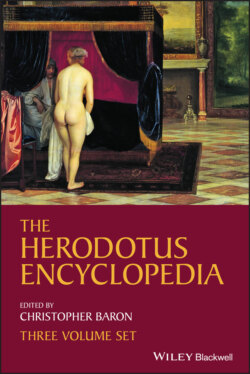Читать книгу The Herodotus Encyclopedia - Группа авторов - Страница 573
ARES ( Ἄρης, ὁ)
ОглавлениеGIAN FRANCO CHIAI
Freie Universität Berlin
Ares, the god of war, was the son of HERA and ZEUS. In Greek literature, he represents the physical and violent aspect of war (Burkert 2011, 259–61). We find such a metaphoric use of Ares in a Delphic ORACLE quoted by Herodotus (7.140). Describing Egyptian religion, Herodotus mentions the FESTIVAL celebrated in the city of PAPREMIS in honor of Ares, probably the Greek interpretatio of the Egyptian god HORUS or Onuris, said to be the sixth‐most important in EGYPT (2.59.3). During the procession of the Ares cult statue, the celebrants attack each other with wooden clubs, staging a fight (2.63; see Lloyd in ALC, 279–80).
Ares is said by Herodotus to be particularly worshipped by the SCYTHIANS; it is their practice to make images and ALTARS and shrines for Ares, but for no other god (4.59). According to Herodotus, each district in Scythia has an Ares temple, built by piling up bundles of sticks. On this sacred pile, three‐eighths of a mile wide and long, they set up a short IRON sword (akinakes) that represents the cult image (agalma) of the god. The Scythians sacrifice sheep, goats, and HORSES in honor of this sword; furthermore, they sacrifice one man in every hundred from among the enemies that they take alive, in a gruesome procedure described at some length (4.62; see Corcella in ALC, 623–28).
Herodotus reports (5.7) that the THRACIANS worship only Ares, DIONYSUS, and ARTEMIS (Asheri 1990); he also mentions an Ares oracle sanctuary among a people serving in XERXES’ Persian invasion force, whose name has dropped out of our MANUSCRIPTS (7.76; Vannicelli and Corcella 2017, 387–88).
SEE ALSO: Ethnography; Human Sacrifice; Religion, Greek; Ritual; Temples and Sanctuaries
